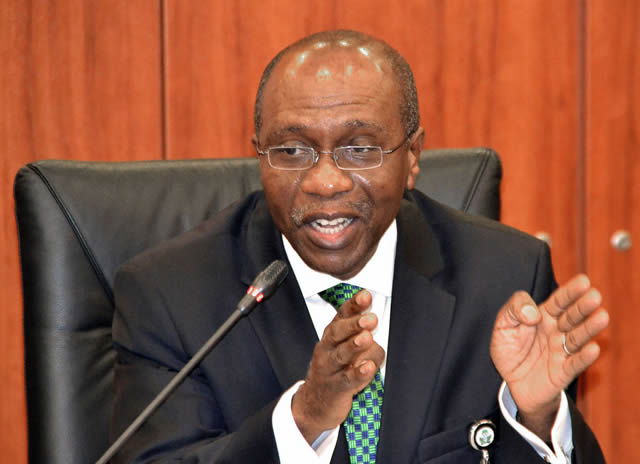Markets
CBN Directs Banks to Allocate 60% of FX Sales to Manufacturers
Published
8 years agoon

Desirous of stimulating economic activities in the country, the Central Bank of Nigeria (CBN) monday directed commercial banks and other authorised dealers in the foreign exchange (FX) market to ensure that they channel 60 per cent of total FX purchases from all sources (interbank inclusive) to end users strictly for the purpose of importation of raw materials, plant and machinery.
The central bank said it took the decision following its review of returns on the disbursement of FX and observed that a negligible proportion of FX sales were being channelled towards the importation of raw materials for the manufacturing sector.
The CBN gave the directive in a circular signed by its acting Director, Trade and Exchange Department, Mr. W.D. Gotring. The letter dated August 22, 2016, was posted on the central bank’s website.
It said: “Following the review of returns on the disbursement of foreign exchange to end users, it has been observed that a negligible proportion of foreign exchange sales are being channelled towards the importation of raw materials for the manufacturing sector.
“Against this background and in order to address the observed imbalance, authorised dealers are hereby directed to henceforth dedicate 60 per cent of total foreign exchange purchases from all sources (interbank inclusive) to end users strictly for the purpose of importation of raw materials, plant and machinery.
“The balance of 40 per cent should be used to meet other trade obligations, visible and invisible transactions. For the avoidance of doubt, authorised dealers are to continue to publish weekly sales of FX to end users in the national newspapers and to render statutory returns on same to the CBN promptly. Please ensure compliance accordingly, until otherwise advised.”
The President of the Manufacturers Association of Nigeria (MAN), Frank Jacobs, recently voiced concerns that the FX scarcity and rising cost of funds had sent manufacturing output plunging to below 20 per cent.
But with the directive, analysts said yesterday that manufacturers would be able to get a substantial part of their FX requirements met.
One market observer lauded the CBN for the directive, adding: “The CBN with this directive has prioritised the real sector so that industries can bring in their raw materials, machines and equipment without having to wait for the banks for weeks and months on end to smile their way.
“This means that the banks and authorised dealers will be required to seek out and prioritise their customers who need to bring in raw materials, plant and machinery for production and not the other way round.
“This is bound to have a positive impact on productivity in the manufacturing sector and hopefully will lead to a drop in the prices of goods that they produce.”
In a related development, the President, Association of Bureau De Change Operators of Nigeria (ABCON), Alhaji Aminu Gwadabe, has said most banks were yet to comply with the CBN’s directive that they sell $50,000 from diaspora remittances to bureau de change (BDC) operators on a weekly basis.
In a statement yesterday, the ABCON boss said only 10 per cent of BDCs from the Lagos market had accessed dollars from banks since the CBN gave the directive nearly three weeks ago.
The banks that have complied include First Bank of Nigeria Limited, Ecobank Nigeria Plc, Fidelity Bank Plc, United Bank for Africa Plc, Unity Bank Plc, Diamond Bank Plc, Zenith Bank Plc and Stanbic IBTC Bank.
Gwadabe further disclosed that BDCs in Port Harcourt, Kano, Abuja, Onitsha, Maiduguri, Benin and Enugu were yet to buy dollars from banks.
He said the BDCs had been selling dollars between N345 and N355 to dollar, far above the interbank rate, because of the shortfall in supply.
The banks, he added, are supposed to sell to the BDCs on the same day within the week, but failed to do so.
“Instead of staggering the payment, the banks should sell to the BDCs on the same week day, so that the impact will be felt in the market.
“We also want the CBN to license new International Money Transfer Operators (IMTOs) to deepen the market.
“Our members across the country have funded their accounts two weeks ago but the banks are not selling to them. The BDCs that met the CBN’s policy guidelines on the disbursement and were cleared by the banks have still not received a dime from the banks,” he said.
Gwadabe called on the CBN to outsource the dollar distribution role to an independent distributor since the banks have failed in their assigned role.
“I think the banks are compromising the policy and CBN’s directive on the matter. And like I said earlier, since the banks are not co-operating, I expect the CBN to take that role from them and assign it to a reputable independent distributor,” he said.
The CBN had directed authorised dealers that are agents of approved IMTOs to sell foreign currency accruing from inward money remittances to licensed BDCs.
The spot rate of the naira appreciated on the interbank FX market to N308.73 to the dollar monday, as against the N316.55 at which it closed last Friday.
The gains made by the naira on the interbank market yesterday were attributed to dollar sales by the central bank to some banks. Traders said the central bank selectively sold dollars to commercial lenders just before the market closed.
The central bank remains the major supplier of dollar in the market and has been selling the greenback almost daily to boost liquidity as the naira continues to search for an equilibrium price.
The CBN ditched its 16-month-old peg on the naira last June and introduced a flexible exchange rate regime to allow the currency to trade freely on the interbank market.
However, on the parallel market, the naira closed at N396 to the dollar yesterday, slightly stronger than the N396.55 to the dollar as of Friday last week.
Meanwhile, Nigeria’s search for an end to its dollar shortage woes dimmed yesterday, when oil prices fell more than two per cent from last week’s high, following expectations of more crude shipments from Iraq and Nigeria, coupled with rising US oil rig count and increased Chinese exports.
While Iraq’s plan to increase exports of Kirkuk crude by 150,000 barrels per day this week from northern fields weighed on prices, the weekend’s announcement by the Niger Delta Avengers that it was ready for ceasefire and dialogue with the federal government also raised expectations of oversupply in the international market.
A prolonged ceasefire by the Avengers will potentially lead to the recovery of over 700,000 barrels per day that was shut in due to the attacks on oil facilities by the militant group, thus adding to the oversupply in the market.
Minister of State for Petroleum, Dr. Ibe Kachikwu, said recently that Nigeria would require an additional 900,000 barrels per day to achieve the 2016 production target.
A stronger dollar was also said to have fuelled the price drop, as the currency rose yesterday against other major currencies on increased expectations that the US Fed could raise interest rates this year.
A stronger dollar makes oil, which is priced in dollars, more expensive for buyers using other currencies, reducing demand.
With the expectations of oversupply weighing on the prices, the global benchmark, Brent crude yesterday was down $1.34, or 2.6 per cent, at $49.54 a barrel, after hitting a two-month high of $51.22 on Friday.
US West Texas Intermediate (WTI) crude’s most active contract, October, fell $1.28, or 2.5 per cent to $48.32 a barrel, after hitting a six-week high of $49.60 on Friday.
Reuters reported that China’s July diesel and gasoline exports soared 181.8 per cent and 145.2 per cent respectively, from the same month last year, putting pressure on refined product margins.
Citing data from the oil service firm, Baker Hughes, the Wall Street Journal also reported that the number of rigs drilling for oil in the US has risen for eight straight weeks.
According to the data, US oil output has fallen for more than a year after companies sharply cut spending on new drilling, but higher oil prices in recent months have prompted some companies to put new rigs to work.
US producers added 32 new rigs in shale-oil regions in August, which could add 200,000 barrels a day of new supply, according to an analyst at SEB Markets.
Oil rallied with few stops over the past two weeks, going from a bear to bull market as it reversed a loss of over 20 per cent in early August on speculation that Saudi Arabia and the rest of the Organisation of Petroleum Exporting Countries (OPEC) will agree to a production freeze with non-OPEC members.
Is the CEO and Founder of Investors King Limited. He is a seasoned foreign exchange research analyst and a published author on Yahoo Finance, Business Insider, Nasdaq, Entrepreneur.com, Investorplace, and other prominent platforms. With over two decades of experience in global financial markets, Olukoya is well-recognized in the industry.

You may like
-


Zhongshang Fucheng Moves to Auction Nigerian Properties in UK Following $70M Arbitration Award
-


Nigerians and Indians Lead UK Job Market Growth Amid Post-Brexit Migration Shifts
-


Violent Protests Erupt Across Nigeria, Leaving Six Dead and Many Injured
-


Nigerian President Tinubu Condemns Protest Plans Over Economic Woes
-


Nigeria to Suspend Import Levies on Food Crops to Ease Inflation Pressure
-


Nigeria Leads Africa in Private Equity Deals, Records $2.59 Billion in Q1 2024








